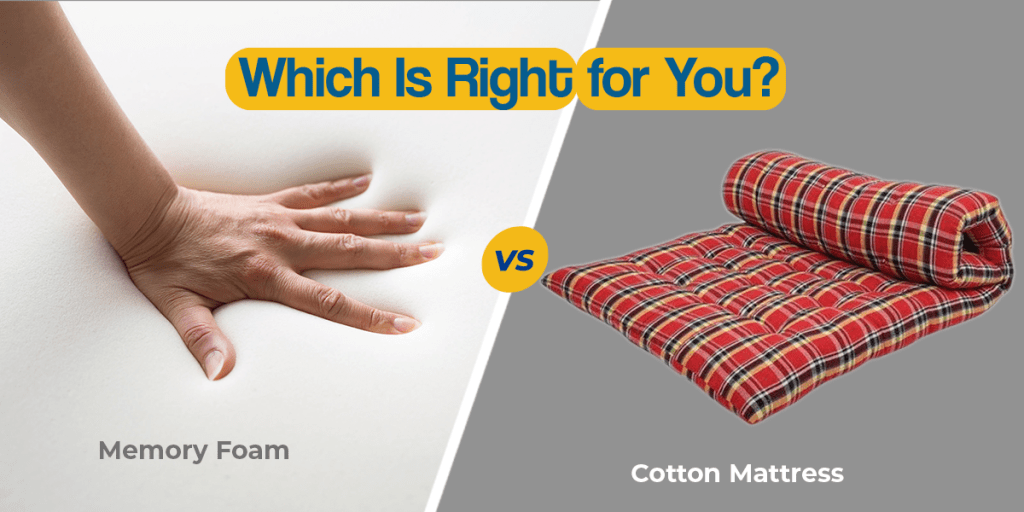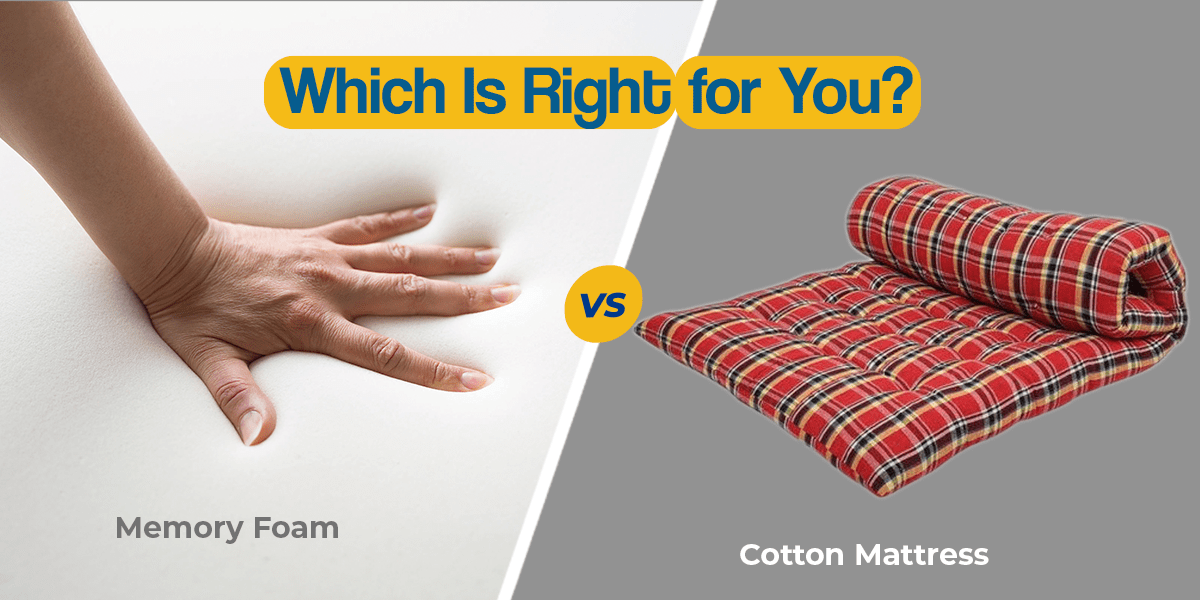
Introduction
Do you wake up in the morning feeling more exhausted than when you went to sleep? Perhaps it is high time you changed your mattress. Sleep is vital to your health, and getting a good night’s rest depends on having the right mattress.
The right mattress provides comfort and helps increase productivity and proper body functioning. Centuary Mattress is a leading company, and we are here to help you make the right choices for your sleep health. In this comprehensive guide, we will examine the key distinctions between cotton and memory foam mattresses to help you make the right decision.
What is a Cotton Mattress?
Cotton mattresses are among the oldest forms of bedding. For many generations, they were the preferred option for people of all ages who wanted a good night’s sleep in a quiet and comfortable environment. The use of cotton mattresses can be attributed to the following characteristics: softness, breathability, and good air circulation. These features add comfort and control the temperature for a cooler sleep. Also, cotton mattresses are relatively cheap, and anyone who requires a mattress can afford it without straining.
Differences Between Cotton Bed Mattress & Memory Foam Mattresses
Selecting the right mattress is critical to having a good night’s sleep and being healthy. Two types of mattresses are cotton mattresses and memory foam mattresses, which have their own benefits and drawbacks. It is thus important to understand the differences between them so as to make a decision that is right for you depending on your comfort level and sleeping habits.
| Feature | Cotton Mattress | Memory Foam Mattress |
|---|---|---|
| Material | Made from natural cotton fibres | Made from synthetic viscoelastic foam |
| Comfort Level | Soft and firm but may lose shape over time. | Conforms to the body, providing pressure relief |
| Support | Provides moderate support, may not adapt to body contours | Excellent support by moulding to the body’s shape |
| Breathability | Highly breathable, promotes good airflow | Less breathable, may retain heat unless infused with cooling gels. |
| Durability | Prone to sagging and flattening over time | Long-lasting, retains shape over many years |
| Motion Isolation | Minimal motion isolation and movement can be felt. | Excellent motion isolation minimises partner disturbance. |
| Maintenance | Requires regular fluffing and airing to maintain shape | Low maintenance, requires only occasional cleaning |
| Hypoallergenic | It may attract dust mites and allergens | Generally hypoallergenic, resistant to dust mites |
| Weight | Lightweight and easy to move | Heavier and harder to move |
| Temperature Regulation | Cool and breathable for a comfortable sleep | Tends to retain heat unless specifically designed with cooling technology |
| Firmness Options | Limited firmness options | A wide variety of firmness levels are available |
| Cost | More affordable and budget-friendly | More expensive due to advanced technology |
| Eco-Friendliness | Natural and biodegradable, environmentally friendly | Synthetic material, less eco-friendly |
| Odour | Odour-free as it uses natural fibres | It may have an initial chemical smell (off-gassing). |
| Pressure Relief | Provides decent support but may not relieve pressure points. | Excellent for pressure relief, reducing strain on joints |
| Customisation | Limited customisation options | Highly customisable with options like gel-infused, cooling, etc. |
Benefits of Cotton Mattress vs. Memory Foam Mattress Benefits
When choosing a mattress, one must consider the advantages and disadvantages of each type to select the most suitable one for one’s needs. Cotton and memory foam mattresses are both good in their own way. Here is a comparison table that will show you the benefits of each type of mattress so that you can easily determine which one is suitable for one’s needs.
| Aspect | Benefits of Cotton Mattresses | Memory Foam Mattress Benefits |
|---|---|---|
| Natural Material | Made from natural, eco-friendly cotton fibres | Made from advanced, hypoallergenic materials, often infused with cooling technologies |
| Breathability | Highly breathable and promotes better airflow for cooler sleep. | Adapts to body heat, but newer models often feature cooling properties. |
| Temperature Regulation | Naturally cool, ideal for hot climates | Provides temperature-sensitive contouring that ugh may retain heat. |
| Eco-Friendliness | Environmentally friendly, biodegradable materials | Some eco-friendly options are available, though less common than cotton |
| Affordability | Generally more affordable, suitable for budget-conscious buyers | Higher initial investment but long-lasting value and support |
| Lightweight | Easier to move and handle due to its lightweight construction | Heavier, but rarely needs to be moved due to its long lifespan |
| Softness & Firmness | Naturally soft with moderate firmness; balances comfort and support | Excellent body support by conforming to body shape, especially for joint relief |
| Allergen ResistanIt can | Can attract dust mites and allergens, though regular maintenance helps | Naturally resistant to dust mites and allergens, great for allergy sufferers. |
| Maintenance | Requires regular fluffing and airing to maintain shape | Low maintenance keeps its shape without the need for regular care. |
| Durability | It may flatten over time, requiring periodic replacement. | Highly durable, maintains shape and support for many years |
| Pressure Relief | Moderate pressure relief supports a healthy sleep posture. | Exceptional pressure relief, reducing strain on joints and muscles |
| Motion Isolation | Minimal motion isolation and movement can be felt. | Excellent motion isolation minimises partner disturbance during sleep. |
Memory Foam Mattress Price vs Pure Cotton Mattress Price
When buying a mattress, the price is an essential consideration when deciding which type to go for. Memory foam and pure cotton mattresses are two types of mattresses in high demand in the market, and they come in different prices and with different qualities.
Memory Foam Mattress Price
Memory foam mattresses are famous for their comfort, pressure relief, and support. Since they are made using sophisticated technology and better materials, they are usually more expensive than other types of mattresses.
The cost of memory foam mattresses varies depending on the brand, thickness, and other features like cooling gel and can range between ₹10,000 and ₹50,000 or more. However, the durability and comfort they offer make them a long-term investment in quality sleep most of the time.
Pure Cotton Mattress Price
On the other hand, pure cotton mattresses are more traditional and are cheaper than memory foam mattresses. Cotton mattresses are made from natural fibres, which makes them environmentally friendly and breathable, which is good for people with sensitive skin.
Cotton mattresses are comparatively cheaper and cost between ₹5,000 and ₹20,000 based on the size and quality. Although they do not have the same contouring properties as memory foam, they offer great breathability and are cooler to sleep on, especially in warmer climates.
Who Should Choose a Cotton Mattress?
A cotton bed mattress is ideal for people who want natural materials, good breathability, and sustainability in their mattress. Although there are many types of mattresses, such as memory foam and other synthetic ones, cotton mattresses have their own advantages that can meet certain requirements. Here’s who would benefit most from choosing a cotton bed mattress:
- Eco-conscious sleepers
- Hot sleepers
- People with allergies or sensitive skin
- Traditionalists
- Budget-conscious shoppers
Who Should Choose a Memory Foam Mattress?
Memory foam mattresses are specifically designed to provide personalised comfort and support, which makes them ideal for a variety of sleepers. Below is the list of who should choose a memory foam mattress:
- People suffering from chronic pain
- Side sleepers
- Couples seeking motion isolation
- Those who prefer a soft hugging sleep
- allergy sufferers
- Cold sleepers
Final Considerations When Choosing Between Cotton and Memory Foam
When choosing between a cotton and a memory foam mattress, one should take into account his or her needs, sleeping patterns, and pocket. Cotton mattresses are more comfortable, environment-friendly, and cheaper than other types of mattresses, especially when used in areas with hot weather. But they may collapse or become weak in their support after some time has elapsed.
Memory foam mattresses are comfortable, conforming, and good at isolating motion, but they can be pricier and tend to trap heat unless they are infused with some cooling features.
Ultimately, the right choice depends on what best suits your individual needs. Explore Centuary’s range of mattresses to find the perfect match for your sleep requirements and enjoy a restful night’s sleep tailored to your comfort.
Conclusion
Cotton bed mattresses and memory foam mattresses are two types of mattresses available in the market, and the decision to choose between the two is based on factors such as comfort, cost, and durability.
If you are looking for a high-quality, innovative mattress that offers excellent sleep support, you should consider Centuary mattresses. Centuary offers a variety of options in the market, both cotton and memory foam, thus catering to everyone’s needs.
FAQs
Memory foam mattresses are usually more effective in supporting the back since they conform to the shape of the body and relieve pressure points that may cause improper spine positioning. This makes them suitable for people with chronic pain or those who require additional support. For better back support, visit Centuary’s memory foam collection, which provides the best comfort and support for sound sleep.
Cotton mattresses are cheaper and cost between ₹5,000 and ₹20,000, while memory foam mattresses are more expensive and cost between ₹10,000 and ₹50,000 because of the additional features. Although cotton is affordable, Centuary’s memory foam mattresses are a long-term investment towards a good night’s sleep. It is up to your budget and comfort level—check out our selection to discover the best model for you.
Natural materials such as cotton used in mattress manufacturing may harbour dust mites and allergens that may be unsuitable for some people. On the other hand, memory foam mattresses are mostly hypoallergenic and do not support dust mites. For those with allergies, Centuary has memory foam mattresses free from dust mites and other allergens.
Cotton mattresses have a durability of approximately 5-7 years before they develop an indentation and become unsupportive. Memory foam mattresses, however, are more durable and can last 10–15 years while retaining their original shape and support. Your decision will. Therefore, it depends on how long you want your mattress to serve you and how comfortable you want it to be. To learn more about quality and improved sleep solutions, visit Centuary Mattress.

